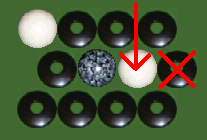 Add a ball to the board, then remove one of the rings from the edge of the board
(note: you can only remove a ring if it is free on two adjacent sides).
Add a ball to the board, then remove one of the rings from the edge of the board
(note: you can only remove a ring if it is free on two adjacent sides).
Zertz is played on an ever-shrinking "board". At the start of the game, the players lay out a grid of moulded rings, making a hexagonal board 4 rings to a side. The pieces are gorgeous speckled balls about 1" in diameter, which sit firmly in the rings. The objective of the game is to capture 3 white balls (out of 5), 4 grey balls (out of 7), 5 black balls (out of 9), or two of each. The pieces start in a common pool, and are not owned by either player.

Each move, you either:
Capture, by jumping a piece with another... it is possible to capture multiple
pieces in a single move, and capturing is compulsory if possible.
 Add a ball to the board, then remove one of the rings from the edge of the board
(note: you can only remove a ring if it is free on two adjacent sides).
Add a ball to the board, then remove one of the rings from the edge of the board
(note: you can only remove a ring if it is free on two adjacent sides).
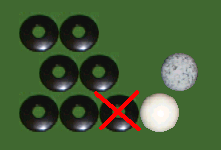
It is also possible to capture balls by isolating an area of the board; if you manage to
isolate one or more balls, with no empty rings around them, then they are captured (and the
empty rings are removed from the game).
Removing the ring shown captures 1 white and 1 grey ball.
Those are more or less all the rules, but this seemingly simple game offers lots of depth, and really feels like nothing else on the market. A lot of the strategy springs from the fact that capturing is compulsory (and doesn't allow the capturer to remove a ring from the board). If you recall, you need only 3 white balls to win the game, so in principle, you can give your opponent 4 black, 3 grey, and 1 white ball and still win. This means you can give your opponent long sequences of forced moves in order to isolate the pieces you need to win, or set up an advantageous double-capture...
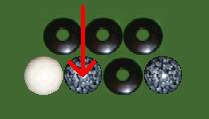
A simple example. Here, you can exchange a black ball for a white ball by placing a
black ball in the space marked. Your opponent must capture, setting you up to capture the
white ball.
… all in all, Zertz is a very dangerous game with much of the feel of a puzzle. It's a game where I'd expect an experienced player to wipe the floor with a novice and in fact, even with only 3 balls on the board, the odds are good that an expert can gain a strong advantage. (When you start to get that good, it's time to switch to the advanced rules, which require 4 white, 5 grey, 6 black, or 3 of each to win.)
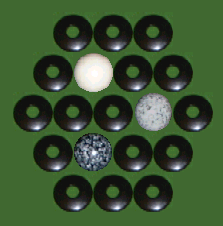
I thought I'd introduce this pattern to you since it's safe - so long as all the
balls on the board are in this pattern, neither player will gain an advantage from a series of
forced captures. It does require a little cooperation from both players to set up in the first
place, but it's a change of pace from the usual brutal exchanges.
Zertz is the third game in the GIPF Project - Kris Burm's innovative series of abstract games. The project is a series of unrelated games, linked together through the original game, GIPF and a series of potentials. Each new game in the series adds a new piece (potental) to GIPF with a special move. This move can either be played automatically, or tied to another game, so a player wishing to make a special move must win the other game before completing his move in GIPF. (The Zertz potential introduces a new type of move into GIPF; it can move over one or more occupied spaces, to land in the first free space.)
For those who haven't seen the other games in the series, they are well worth a look. GIPF is a very deep abstract game where players slide pieces onto the board, attempting to make lines of 4 and capture opponents' pieces. TAMSK is not so deep, but is a stunning design, and the only game I have seen that uses time as a strategic element (the playing pieces are egg timers, flipped each time they move, which die if they run out of sand). The GIPF project logo is very much a mark of originality and quality in my eyes, though that same originality means that different games in the project may well appeal to different audiences.
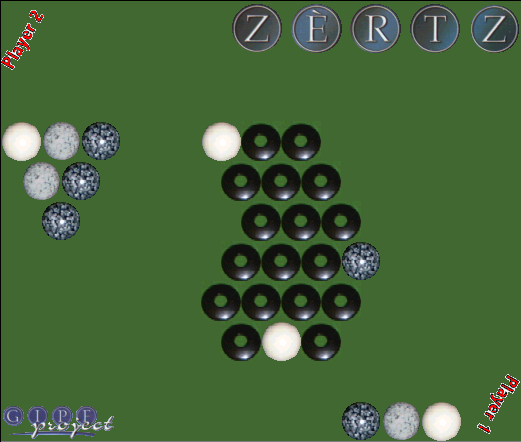
I thought I'd leave you with a puzzle. Basic game, player 1 to play and win.
A slightly easier form of this puzzle appeared in the original G3 article.
Click here for the solution.
You can find out more about the GIPF project at http://www.gipf.com.